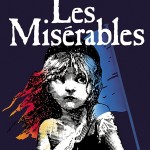Ever since I first read the essay “What’s the Difference?” on the now defunct website wssonstage.com, comparing an contrasting the stage and film versions of West Side Story, I knew I wanted to write a similar comparison of the stage and film versions of Les Misérables. Now that the Les Mis film has finally been released, I have more material to write about than I ever dreamed I would. While not drastically different from Herbert Kretzmer’s stage libretto, William Nicholson’s screenplay is far from the “cut and paste job” that some critics assume it is.
First of all, the film strives to bring the musical’s action closer to Victor Hugo’s novel than it is onstage. Secondly, it shortens the show’s nearly three-hour running time to create a screen product for the masses. Third, the filmmakers take the opportunity for a fresh look at old material that, for all its excellence, still has room for improvements. Most importantly of all, to quote the West Side Story essay, “a movie screen is filled out differently than a live stage is.” The stage version of Les Mis is usually performed on an abstract unit set and the libretto is full of what I like to call “Theatrical Suspension of Disbelief,” or “TSOD.” Details that feel convincing in a stage context, but are actually far from realistic. (Note: TSOD isn’t an example of bad writing. Shakespeare used it all the time.) The filmmakers had the tremendous task of bringing the work into a facsimile of the real world.
Like the author of the West Side Story “What’s the Difference?” essay, I make no attempt to argue that one version is better than the other, though my personal biases will probably still be clear. My task may be more complicated, though, because while WSS has only one stage version, Les Mis has repeatedly been revised. For this essay, my main source for the stage version is the 1988 Complete Symphonic Recording and the libretto enclosed with it. I’ll occasionally mention other versions of the score, though: particularly the shortened version widely adopted in the early 2000s. For details of staging, costuming, etc. that the libretto doesn’t specify, my chief source is Trevor Nunn and John Caird’s classic 1985 production with its famous revolving stage, though I’ll sometimes mention the controversial 25th Anniversary Tour production too. My sources for the film are the finished product and the screenplay as published online by Universal.
Prologue (Work Song)
Of course the stage version lacks the film’s striking, symbolic opening shot of a tattered, torn French flag floating on the ocean’s surface. It also lacks the caption explaining the political situation of France in 1815, not to mention the soft, ominous drumbeat that is the film’s first music. Onstage we plunge into the drama with the chords of “Look Down” thundering from the orchestra, and (in the classic Nunn/Caird production) only the words “1815, Toulon” projected on a scrim to set the scene.
“The Chain Gang, overseen by brutal warders, work in the sun,” reads Herbert Kretzmer’s first stage direction. The convicts are traditionally shown swinging hammers, apparently breaking rocks at a quarry. Some productions have opted for different staging (the 25th Anniversary Tour anachronistically has them rowing a prison galley), but very few. The film, however, draws on the actual type of labor that Toulon prisoners did to create a grander, more epic opening scene. The action unfolds at a wind- and rain-swept dock where not one, but dozens of chain gangs work together to haul a massive storm-damaged warship from the sea.
The film also introduces us to our hero, Jean Valjean, and his nemesis, Javert, much sooner than the stage version does. Before a single note is sung we see Valjean in close-up, followed by the image of Javert watching the convicts from atop a wall. The two are shown eyeing each other throughout the Work Song, Valjean angry and Javert impassive, suggesting a longtime antagonism that the stage version never implies. Additionally, the song’s opening line, “Look down, look down, don’t look ‘em in the eye!” is sung not by all the convicts as it is onstage, but by Valjean alone.
Two other changes are made on film to the Work Song as well: the grunts of the convicts, which onstage are sung to the “Look Down” melody (“A-ha, a-ha, a-ha…”), are changed to realistic grunts, and in keeping with the cold, wet setting, the line “The sun is strong, it’s hot as Hell below!” is altered to “No God above and Hell alone below!”
Those waiting to hear the first line sung by the stage Javert, “Now bring me Prisoner 24601!” will be surprised to hear Russell Crowe’s Javert instead command Valjean (who has already been brought to him) “Retrieve the flag,” in speech instead of song! This is the first of many snatches of spoken dialogue heard throughout the film, in contrast to the fully sung stage version. It also leads into an orchestral reprise of the “Look Down” refrain, during which Valjean lifts and moves the ship’s enormous broken flagpole with near-superhuman effort. This very clearly and dramatically establishes Valjean’s tremendous strength to both Javert and the audience – no such moment exists onstage. Only afterwards does Javert launch into his first sung passage, “Now, Prisoner 24601…”
Javert and Valjean’s first exchange is slightly altered as well. Onstage we learn more about Valjean’s crime (it wasn’t only theft, but breaking and entering), while on film, Javert elaborates on why a yellow ticket-of-leave does not equal freedom, namely that it’s a badge of shame.
I suppose this is as good a time as any to mention a particularly key difference between the stage and film versions. Onstage, Valjean has a prison brand on his chest. This is used as an easy, visually striking way for characters to identify him at different points in the drama. However, this is an anachronism. Convicts were not branded in post-revolutionary France, Valjean has no brand in the novel, nor does he have one on film. This change forces certain scenes to be rewritten significantly.
On Parole
Once the chain gang exits, the stage Valjean sings a monologue expressing his joy at being free. On film, this musical passage becomes largely orchestral as we see a more overwhelmed and dumbstruck Valjean make his way up an alpine hill at sunrise. When he finally sings, his words are “Freedom at last… how strange the taste!” followed by only the last five lines of his stage monologue.
Here we come to the film’s first major departure from the stage score. At this point onstage are two brief successive scenes, as Valjean first finds work on a farm, then seeks shelter at an inn. Each begins with an orchestral reprise of “Look Down,” followed by a sung exchange. The farmer pays Valjean only half wages due to his status as an ex-convict and the innkeeper turns him away. Valjean follows each sequence by singing of his bitterness. The inn scene also includes a brawl in which Valjean attacks a man who shoves him – early evidence that his anger is excessive.
The film turns this section into a montage that, as they say, “shows” rather than “telling.” The orchestral music is rewritten and bits of spoken dialogue replace the singing. The inn sequence plays out as it does onstage (minus the brawl), but the farm is replaced by a quarry and Valjean is outright denied work rather than underpaid. We also see images of him reporting at a parole office, being pelted with stones by children and being beaten by policemen, which have no stage basis.
The Bishop (Valjean Arrested/Valjean Forgiven)
For all their differences, both “parole” sequences end the same way, with the weary, disconsolate Valjean found and invited indoors by the Bishop of Digne. But no sooner has the Bishop sung his first passage then the film gives us another departure. Onstage, after eating with the Bishop, Valjean sings another monologue, describing the evening leading up to the theft of the Bishop’s silver. This is probably the strangest, most awkward monologue in the musical, because it’s the only one written in past tense. It’s as if we’re suddenly hearing the older Valjean’s memory of stealing the silver, even though before and afterwards we’re always in the present with him. It’s just as well that the film replaces this odd passage with a mostly silent montage, even though Valjean loses a thrilling high note (“…took my FLIGHT!”) in the process.
When the constables bring Valjean back, their lines onstage are sung and addressed to Valjean (“Tell his Reverence your story/Let us see if he’s impressed”) but replaced by briefer spoken lines on film, addressed to the Bishop (“Monsignor, we have your silver!”) The Bishop’s saintly response is identical in both versions, except that a few words on film are spoken rather than sung, and he declares in the end that he has “saved,” rather than “bought,” Valjean’s soul for God.
Valjean’s Soliloquy (What Have I Done?)
In the classic Nunn/Caird production, this tour-de-force solo is sung on a bare stage, while the 25th Anniversary Tour places it in the square in front of the Bishop’s house. The film departs from both by placing Valjean in the Bishop’s church, kneeling in repentance before the altar, then charging out into the churchyard to tear up his yellow passport.
At the End of the Day
One of the most iconic images from the original stage production is the beginning of this song, with its mass of poor people that fill the stage, running and stumbling forward with hands outstretched and singing out to the audience as if begging them for alms. But powerful though this image may be, it is, of course, stagy, and wouldn’t work on film. Therefore, onscreen the masses of beggars are not singing out to us, but huddled in a bleak archway outside the gates of Montreuil-sur-Mer. The sequence retains its power, however, as we see close-ups of filthy pox-marked faces, crippled bodies, and the corpses of disease victims being loaded onto carts as their families weep. One minor lyric change emphasizes this last image: a reference to “the winter” becomes “the plague.”
The film scene also continues the trend of incorporating principle characters into “chorus” scenes by showing Javert and other policemen riding past the beggars on horseback as they enter the city. This gives visual life to the words “And the righteous hurry past…”
We now move on to the factory in both versions. In the traditional Nunn/Caird staging, this scene has both male and female workers loitering by the factory gate, having finished their day’s work and waiting to approach the foreman’s desk for pay; in the end poor Fantine approaches the desk only for the foreman to shut the cashbox and fire her. The film, however, follows the 25th Ann. Tour’s example by setting the scene in the women’s workshop, showing them busy stringing jet beads at long tables, and the only men present are the foreman and later Valjean.
In both versions, the discovery of a letter to Fantine from the Thénardiers leads to a fight, which is broken up by “the Mayor’s” arrival. Onstage, after order is restored, Valjean leaves without explanation. The film, however, gives a dramatic reason for his quick departure. Amid an orchestral reprise of “Look Down,” he sees Javert glancing down at the workshop from the balcony of his own office. At that moment, to quote the published screenplay, “his world drops away.”
Incidentally, the film has two women reveal Fantine’s secret rather than just one. (Onstage, the one factory girl who tells all is usually implied to be the foreman’s mistress and jealous of his attention to Fantine – an implication not found onscreen.) Fantine’s frantic screams for help as the foreman throws her out the door, and Valjean hearing but being too distracted by Javert to take action, are also unique to the film.
STAGE: I Dreamed a Dream
“Alone, unemployed and destitute” (to quote the libretto), the stage Fantine sings what has become the musical’s most famous song. Sung at the height of her dignity, with her flowing hair and respectable clothing still intact, this beautiful ballad makes us fully engage with Fantine as a character, more than the fast-paced factory scene could have done alone. It enhances the effect of all the horrors she subsequently faces.
FILM: Javert’s Introduction
The filmmakers seem to have had strong faith in the power of their medium’s intimacy. They seem to have realized that through close-ups and effective cinematography, they could make us fully engage with Fantine during the factory scene, without her needing a solo afterwards. Therefore, we leave Fantine for the time being and shift our attention to “Monsieur le Mayor” and Javert. In a new scene written for the film, sung to music originally used in “Valjean’s Confession” onstage, Javert introduces himself and compliments the mayor on the town’s prosperity, yet has the strange, unshakeable feeling of having met him somewhere before.
FILM: The Runaway Cart
This scene comes at a later point onstage, but the film places it here to bring the action closer to the novel (see “Javert’s Confession”). Valjean and Javert hear an off-screen crash and hurry out to the yard to find Fauchelevant trapped under his cart. The scene is shortened for film, with confused realistic shouts replacing most of the stage version’s sung recitative. The actual cart-lifting is rescored as well, with yet another reprise of “Look Down” – appropriately, since Valjean’s lifting of the cart is shot to exactly mirror his hoisting of the mast in the opening scene. This leads to Javert nearly voicing suspicion, but despite Valjean’s “Say what you must, don’t leave it there,” he does leave it there and the scene ends.
Lovely Ladies
This production number is a prime example of the film’s incorporating its leads into “chorus” sequences. Onstage the song opens with the sailors and the whores. Only after each of their stanzas does Fantine enter, then exit, then reenter… first to sell her locket, then to agree to sell her hair, and finally to be persuaded to “join her sisters.” The cutting of her hair takes place offstage, achieved by replacing a long wig with a short one.
On film, Fantine is the first person we see and the number includes her from the start, as she gazes with horror at the vulgarity around her and is taunted by woman-hungry sailors. Likewise, her hair, Anne Hathaway’s real hair, is cut onscreen. And her visceral agony certainly doesn’t end there. The sale of her locket is changed to spoken dialogue and placed before the song itself (and incidentally the buyer is changed from a woman to a man). Within the song her hair-sale becomes the first recitative, and a new second recitative derived from the novel is introduced: a dentist offers to buy her two back teeth and she accepts. The actual pulling isn’t shown, but afterwards we see her huddled in a heap of pain with a bloody mouth.
On film the whores lose their third stanza, but benefit from the realism of the screen. We traditionally find them at center stage surrounding a table and chair, no clear location. On film, of course, they’re shown in their “natural” habitat, singing from brothel balconies and dockside walls.
Onstage, after Fantine’s first customer drags her away, the whores sing out their final stanza to the audience. Fantine then reenters in full whore costume and offers herself to a sailor, who ignores her. On film, the whores sing their final stanza to Fantine as they urge her toward her first customer, and Fantine’s “Come on, captain…” is sung to said customer, as they enter a rotting ship’s hulk that serves as extra brothel space and bed down.
FILM: I Dreamed a Dream
The original French version of the musical in 1980 placed Fantine’s iconic solo at this point, after her turn to prostitution. Only when the show was revised for London was it moved. While the earlier placement may be more effective onstage, there’s no denying the impact on film of the creators’ original intent. Sung in the dark ship’s hulk, with Fantine clad in only her undergarments and her head shorn, sitting on the bed where her last shred of dignity was torn away, the song gains a new level of raw agony, with new meaning brought to such lyrics as “…this Hell I’m living” and particularly “Now life has killed the dream I dreamed.”
Fantine’s Arrest
A clear time skip takes place at this point on film, which the stage version lacks. We sense that Fantine is now an experienced prostitute, and the ground is now covered with snow, which makes her flimsy dress a horrific sight to see. We’re also given an introductory shot of Valjean giving money to a beggar – onstage he only enters late in the scene.
Fantine’s scuffle with Bamatabois is considerably shortened on film, made less verbal and more purely physical. Onstage Bamatabois beats her, while on film, truer to the novel, he stuffs snow down her dress. The result is the same, however, as she fights back, Javert arrives and Bamatabois claims he was attacked – though his plea of innocence is changed from “I was crossing from the park.” to “I was lost here in the dark.”
Valjean’s intervention is met in both versions with the same anger from Fantine, which he follows with the same vow to set things right. But while stage Valjean has Javert’s constables take Fantine to the hospital, film Valjean carries her there himself. In new dialogue he learns Cosette’s whereabouts and promises to send for her. His “I will see it done!” addressed defiantly to Javert onstage (who can forget Colm Wilkinson’s fearsome shout in the 10th Anniversary Concert?), is sung gently to Fantine on film.
STAGE: The Runaway Cart
In addition to coming later, this scene is more melodramatic onstage. Someone shouts “Look out! It’s a runaway cart!” and we’re treated to the spectacle of the whole onstage crowd “running” in slow motion to “escape” it. The “crash” itself is followed by the crowd singing of how Fauchelevant can’t be rescued and begging “the Mayor” not to risk his own life trying. The lifting is underscored with music heard nowhere else.
Unlike on film, when Valjean insists “Don’t leave it there,” Javert obediently continues. He has only known one other man as strong as “the Mayor”: an ex-convict who, he says, has just been rearrested. Depending on the actor, he can either seem to strongly doubt his own words and to suspect “the Mayor” of being Valjean, or to firmly believe that Valjean has been found and be struggling to suppress his “unjust” suspicion. The film, however, offers a completely different take on the scenario.
FILM: Javert’s Confession
In a new sequence derived from the novel, Javert receives a letter and promptly goes back to “the Mayor’s” office. (Incidentally, the obvious time skip between “Fantine’s Arrest” and this scene helps make Fantine’s decline in health more plausible – onstage, TSOD being in full force, she seems to die just hours after being taken to the hospital.)
Javert confesses that he denounced “the Mayor” as an ex-convict only to learn that said convict was already recaptured, and asks the Mayor to press charges against him for his “unjust accusation.” But Valjean is kinder to Javert than the inspector is to himself. The music is recycled from the corresponding stage scene, as are a few lyrics, but this new scene is decidedly less stagy and truer to Hugo than its stage counterpart and reveals the enormity of Javert’s moral code; characteristic of the filmmakers’ efforts to humanize him and avoid portraying him as a villain.
Who Am I?
This song is usually sung on a bare stage, until the very end when a scrim rises to reveal the courtroom. The screenplay shows the intent to turn it into a montage song, with Valjean singing first in the factory, then in his house, then in his carriage, etc. But Tom Hooper seems to have realized that this would only distract from Valjean’s inner struggle, so apart from beginning in the factory and ending in the courtroom, in the finished film the song takes place entirely in Valjean’s house.
Onstage, Javert is present at the trial and Valjean sings “And so, Javert, you see it’s true…” then rips open his shirt to reveal his prison brand. On film, truer to the novel, Valjean has no brand and Javert is not present. So instead he addresses the judge, “And so, your Honor, you see it’s true…” and then tells him to speak to Javert to confirm his identity.
Come to Me (Fantine’s Death)
Fantine’s dying song is shortened on film, but retains its moving effect. Our seeing her hallucination of Cosette is unique to film, while onstage she traditionally staggers out of bed toward “Cosette,” only to be carried back by Valjean. A few lyrics are altered as well. Film Valjean assures Fantine that Cosette will soon be with her, and stage Fantine’s happy “Look M’sieur, where all the children play!” is poignantly changed to “Come, Cosette! My child, where did you go?” as her hallucination fades.
Confrontation
Onstage this battle of wills is traditionally more verbal than physical. Javert, armed with a nightstick, corners Valjean behind Fantine’s bed and the two sing in semi-frozen tension. On film, with “Wolverine” and “Maximus” squaring off, more action was almost inevitable. Javert now has a sword, Valjean breaks a wooden beam from the roof, and the scene becomes an epic duel. The song itself is unaltered, though, until near the end. Valjean’s counterpoint is cut short when Javert disarms him and Javert sings of his “gutter” background alone. This suits the film’s general “humanization” of Javert (his sympathetic backstory can get lost when Valjean is singing at the same time) and rids Valjean of what some theatregoers label excessive aggression: onstage at this point he threatens to kill Javert.
At the duet’s climax, stage Valjean smashes a chair and threatens Javert with one of the legs. Thus keeping him at bay, he sings a reprise of “I Dreamed a Dream” to the dead Fantine, vowing to care for Cosette, while behind him Javert vows to always pursue him. The two then physically fight and Valjean knocks Javert unconscious and escapes. Onscreen, however, Javert corners Valjean at a door that leads to a ledge with the sea below. At the point where stage Valjean smashes the chair, film Valjean escapes by leaping into the sea. The final “I Dreamed a Dream” reprise is cut.






Michele Serchuk
January 6th, 2013 at 15:49
Wow, I have seen the movie, I have seen several productions of the musical and I have come away with feelings not details. Thanks for this encyclopedic rendering of both. This is amazing! It’s a reference book.
Dave S
January 13th, 2013 at 15:04
It may interest yo uto know that the entire wedding chorale/Beggar at the Feast scene was shot, which I know as several people I know were extras in the scene. However due to SBC and HBC apparently repeatedly flubbing/forgetting entirely their lines, the scene took much longer to film and was such cut.
Steve
February 28th, 2013 at 00:50
Many thanks for this excellent comparission. I’m glad you’re using the on-screen film as a guide as well as the script that was released – as that script does have some differences (mainly extra scenes) from the final on screen version.